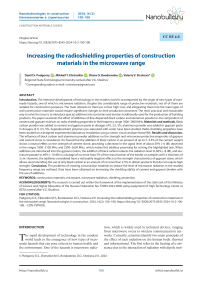Increasing the radioshielding properties of construction materials in the microwave range
Автор: Podgorny D.S., Elistratkin M.Y., Bondarenko D.O., Strokova V.V.
Журнал: Nanotechnologies in Construction: A Scientific Internet-Journal @nanobuild-en
Рубрика: Construction materials science
Статья в выпуске: 2 Vol.16, 2024 года.
Бесплатный доступ
Introduction. The intensive development of technology in the modern world is accompanied by the origin of new types of manmade hazards, one of which is microwave radiation. Despite the considerable range of protective materials, not all of them are suitable for construction purposes. The main obstacle to their use is their high cost, and integrating them into the main types of wall construction materials would require significant changes to their production processes. The most practical and reasonable way to solve the issue is to introduce special additives into concretes and mortars traditionally used for the production of building products. The paper examines the effect of additives of fine-dispersed black carbon and aluminum powder in the composition of cement and gypsum matrices on radio shielding properties in the frequency range 1800–2800 MHz. Materials and methods. Black carbon powder was added to cement and gypsum paste in dosages of 0, 2.5, 5%, aluminum powder was added to gypsum paste in dosages of 0, 2.5, 5%. Superabsorbent polymers pre-saturated with water have been studied. Radio shielding properties have been studied on a designed experimental laboratory installation using a vector circuit analyzer NanoVNA. Results and discussion. The influence of black carbon and aluminum powder additives on the strength and microwave protective properties of gypsum and cement stone is considered. It is found that the addition of black carbon in an amount of up to 3–3.5% of the cement weight shows a neutral effect on the strength of cement stone, providing a decrease in the signal level of about 50% (–6 dB) observed in the ranges 1800–2100 MHz and 2300–2650 MHz, which makes this additive promising for solving the highlighted task. When additives are introduced into the gypsum matrix, the addition of black carbon reduces the radiation level to 60% (–8 dB), and aluminum powder to 69% (–10 dB) in a dosage of no more than 5% of the mass fraction of the binder on samples with a thickness of 3 cm. However, the additives considered have a noticeable negative effect on the strength characteristics of gypsum stone, which allows recommending the use of only black carbon in an amount of no more than 2.5% to obtain products that do not require high strength. Conclusion. The problems of creating construction materials to reduce the level of microwave radiation in the studied frequency range are outlined. Data have been obtained on increasing the shielding ability of cement and gypsum binders with the use of additives.
Construction materials, microwave, microwave radiation, shielding, protection
Короткий адрес: https://sciup.org/142240851
IDR: 142240851 | DOI: 10.15828/2075-8545-2024-16-2-100-108
Текст научной статьи Increasing the radioshielding properties of construction materials in the microwave range
Original article
The rapid development of technology in the modern world leads to the emergence of new types of manmade hazards that can pose a threat to human health and the environment. One of the hazards is microwave radia- tion, which is widely used in technical devices, ranging from microwave ovens to wireless communication networks. Currently, scientists identify two main principles of the effect of such radiation on the human body: thermal and informational. The first refers to the heating of a substance due to the interaction of radiation with dipole mol-
CONSTRUCTION MATERIALS SCIENCE ecules. The second one implies a change in the behavior of the body’s cells, followed by a disfunction of the system and an increase in the risk of diseases. A number of statistical studies indicate that the electromagnetic field (EMF) can provoke the development of cancer, cardiovascular diseases and diseases of the nervous system [1–6].
Some authors point to an increased risk of carcinogenesis for people who frequently use mobile phones [2]. It is noted that pulsed microwave radiation has a negative effect on the human body. A separate risk group includes people living in close proximity (radius up to 400 m) to cellular base stations (BS). According to studies [2, 3], for this group, the risk of developing brain cancer increases during 10 years of living near BS.
Based on the above, it can be concluded that the creation of materials for microwave radiation control may become one of the key tasks of building materials science in the coming years. One of the key aspects for the creation of such materials is the development of a native instrument base for conducting relevant research.
The researchers point out several aspects that cause the high radio-absorbing characteristics of materials when microwave radiation passes through them:
– relaxation losses that are specific for dipole molecules, for example water;
– electrical losses associated with the conversion of an electromagnetic wave into eddy electric currents in a material and then into heat;
– magnetic losses (typical for ferromagnets).
The classical method of shielding electromagnetic radiation, isolating closed volumes from it, is the use of a Faraday cage, i.e. a metal grid or sheet. This method is due to the electrical conductivity of metals and the skin effect, the cell size of the shielding grid should decrease in proportion to the wavelength that needs to be shielded.
However, the integration of metal fillers and grids into the building structure is extremely difficult from a technological point of view and can contribute to the creation of multiple reflections inside the room with the formation of ” hot spots “ .
Currently, there is a large number of specialized materials with high radio shielding properties in the microwave range:
– fiber-reinforced polymer composites (for example, carbon-epoxy), which are characterized by high physical and mechanical properties and the degree of absorption of microwave waves (a decrease in the EMR level can reach –51 dB) [10];
– composites using metal oxides (Mn, Fe, Ti, Ni, Mg, Co) [11–17]. For example, chain composites Fe3O4-pores-mSiO2-MnO2, presented in the work [17] demonstrate a decrease in the level of the passing signal to 99%;
– single-layer and multilayer carbon nanotubes, fullerenes and graphene [10, 18–23]. For example, a com- posite using graphene oxide and polypyrrole shows a decrease of the transmitted signal to 99.8% of the base and is –54.4 dB [20];
– multidimensional materials for the absorption of microwave radiation, having high efficiency due to the structural features of their structure. Such materials can be used to reduce radiation in a wide frequency range [24–28];
– functionalized surface with a large number of defects based on MoS2 also shows high efficiency in shielding microwave radiation [29].
Such a wide range of materials really makes it possible to reduce the level of radiation in special devices and structures, however, most of the listed methods have a number of disadvantages. As a rule, they are associated with the high cost of production, the inability to scale the technological process, the toxicity of the materials used, etc. When developing building materials with special properties, it is necessary to take into account the above disadvantages, while the technology should be easily integrated into existing production lines.
In our opinion, a more realistic and rational way is to introduce additives with high conductivity, dielectric or magnetic permeability into concretes and mortars traditionally used for the production of building products. Such additives can be ferrous ore powders and non-toxic metal oxides, minerals and powders with a high carbon content. It is worth noting separately that currently insufficient research has been conducted related to the study of microwave properties of cement and gypsum stone crystallohydrates.
The analysis of scientific publications [7–31] showed that despite the great interest of the scientific community to the development of specialized materials for the absorption, reflection and transmission of microwave radiation, the number of works devoted to building materials is extremely small, which determines the relevance of their study.
METHODS AND MATERIALS
The research was carried out on the installation developed by the authors [32] (Fig. 1).
The installation consists of two horn antennas, between which the test sample is placed. The NanoVNA V2 vector circuit analyzer (S-A-A-2), pre-calibrated according to the SOLT method, was used as a signal generator and analyzer. The measurements were carried out in the spectrum of the most commonly used frequencies in modern microwave technology (1800–2800 MHz). Data analysis and output were performed using native software for the vector analyzer NanoVNA – VNA QT. The data obtained are the S-parameters of the incident and reflected wave that passed through the antennas to the device ports. The LOGMAG S12 (logarithmic value of
CONSTRUCTION MATERIALS SCIENCE
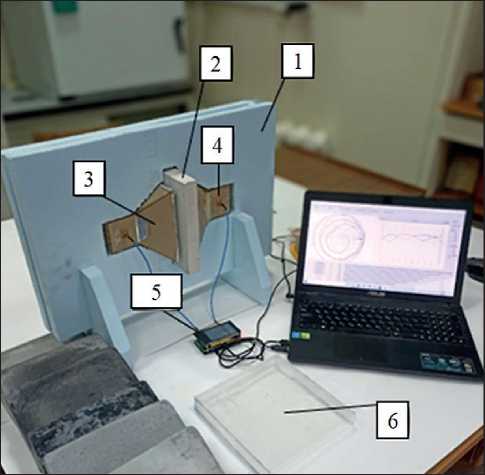
Fig. 1. Prototype of an installation for studying the radio shielding properties of materials in the microwave range: 1 – antenna holder (body), 2 – sample, 3, 4 – antennas, 5 – vector network analyzer, 6 – cell for liquid and bulk materials the transmitted signal) parameter of the device was used to measure absorption.
The sample installation chamber is designed for the use of samples with dimensions of 200×200×30 mm, which makes it possible to consider the material containing a filler up to 10 mm quasi-homogeneous. For the study of bulk and liquid materials, a special cell with dimensions 200×200×30 mm with walls 1 mm thick, made of polymethylmethacrylate, is used.
Gypsum GVVS-16 and cement CEM I 42.5 N were used to produce radio-absorbing materials. These binders are widely used in the construction materials industry to produce a wide range of products.
Table 1
The elemental composition of black carbon
|
Element |
Content, by weight. % |
|
C |
90–99 |
|
H |
0.3–0.5 |
|
O |
0.1–7 |
|
S |
0–1.5 |
|
Si |
0–0.5 |
The first radioprotective additive, black carbon according to State Standard 7885–86, was used in both cement and gypsum matrices. The chemical composition of soot is shown in Table 1. The particle size is in the range of 10–1000 nm.
The second additive, aluminum powder according to State Standard 5494–95, was used exclusively as a gypsum modifier. The particles of this powder are petals 0.25–0.5 microns thick and 20–30 microns in diameter. Aluminum powder was not used for cement-based materials, due to the danger of its interaction with alkalis present in the cement solution.
Additive-free samples of cement and gypsum stone were used as control samples. The compositions of all studied samples are shown in Table 2. The pastes were prepared in a laboratory mixer SL-5.
In all compositions, the water-binder ratio (W/C and W/G) was equal to 0.4.
A special cell was used to evaluate the radio shielding properties of water-saturated superabsorbent polymers (SAP). SAP, according to our assumption, can be used as a possible option for creating protective microwave screens based on water and an absorbing filler for building materials.
SAP balls were prepared by placing dry balls in a separate container with water until they were completely saturated. An increase in their diameter from the initial
Table 2
The studied samples
|
№ of composition |
Type of binder |
Type of additive |
Dosage, % |
|
1 |
Cement |
No additive |
|
|
2 |
Black carbon |
2.5 |
|
|
3 |
Black carbon |
5 |
|
|
4 |
Gypsum |
No additive |
|
|
5 |
Black carbon |
2.5 |
|
|
6 |
Black carbon |
5 |
|
|
7 |
Aluminum powder |
2.5 |
|
|
8 |
Aluminum powder |
5 |
|
CONSTRUCTION MATERIALS SCIENCE r = 2 mm to the maximum R = 7 mm was taken as full saturation, while the volumetric water absorption is:
/ -. 7Г . r3\ / - • 3 14 • 23\
川二( 1 — I------) • 100% = I 1 -1---------J • 100% 二 97,67% .
\ 半 tt.R3, \ 3,14 • 73/
RESULTS AND DISCUSSION
The studies [7, 8] present the results of assessment of the microwave protective properties of some traditional wall materials, which show that classical building materials have rather weak protective properties, and therefore require additional measures to improve them by: – their combination with special materials with high radioprotective properties (plasters, paints, tiles, films, etc.);
– the introduction of special additives into them, at the manufacturing stage, that increase their radio shielding properties.
The second method is the most promising due to the absence of the need to make significant changes in the technology of both production of materials and application in construction.
At the first stage of the research, the influence of radioprotective additives on the strength properties of cement and gypsum matrices was evaluated (Tables 3, 4).
Introduction of black carbon (Table 3) in an amount of 2.5% increases the strength of the stone by 14–17% during all periods of hardening, which, with sufficient protective properties, makes this additive suitable for modification of cement materials. It should be borne in mind that in the composition of real concretes, the bulk of the material volume is formed by a filler, which makes the consumption of this additive per cubic meter relatively small.
An increase in the consumption of the additive to 5% in the early stages has a neutral effect on strength, however, in brand age, its decrease is observed by more than 12%. This dosage of the additive can be justified by a significantly higher achieved level of protective properties, in which the loss of strength can be compensated by an increase in cement consumption in concrete. Higher dosages of soot additives are not advisable, and the recommended maximum amount, based on the neutral effect on strength, is 3–3.5%.
The considered shielding additives significantly reduce the strength of gypsum stone (Table 4). On average, the drop in strength, in the case of the addition of aluminum powder, in the entire range of the considered dosages is more than 70%. This indicates the need to significantly reduce its consumption, which will negatively affect the protective properties of the material.
The addition of black carbon also has a negative effect on strength, however, in the minimum of the dosages considered (2.5%), provided that a high level of protective properties is achieved, it can be recommended for the manufacture of special compositions and products that do not have high strength requirements.
Next, a study of the radio shielding properties of the samples was carried out. Dry samples (Wm < 0.5 %) were placed next to the receiving antenna at a distance of 1 cm, with the distance between the apertures of the antennas being 34 cm. The distance between the waveguides was 50 cm (Fig. 2–4).
Gypsum with black carbon as a radio shielding additive showed a decrease in radiation power from 11%
Table 3
Strength characteristics of cement binder samples
|
Dosage of black carbon in a cement matrix, % |
Strength, MPa / % change in relation to the control |
||
|
2 days |
7 days |
28 days |
|
|
21.4 |
42.2 |
61.9 |
|
|
2,5 |
25.1 / +17.6 |
49.7 / +17.7 |
70.9 / +14.5 |
|
5 |
21.6 / +1,1 |
43.3 / +2.6 |
54,1 / –12.5 |
Table 4
Strength characteristics of dried samples on gypsum binder at the age of 7 days
|
Type of additive |
Dosage, % |
Strength, MPa / % change |
|
33.2 |
||
|
Aluminum powder |
2.5 |
9.5 / –71.4 |
|
5 |
7.2 / –78.3 |
|
|
Black carbon |
2.5 |
20.5 / –38.3 |
|
5 |
14.4 / –56.6 |
CONSTRUCTION MATERIALS SCIENCE
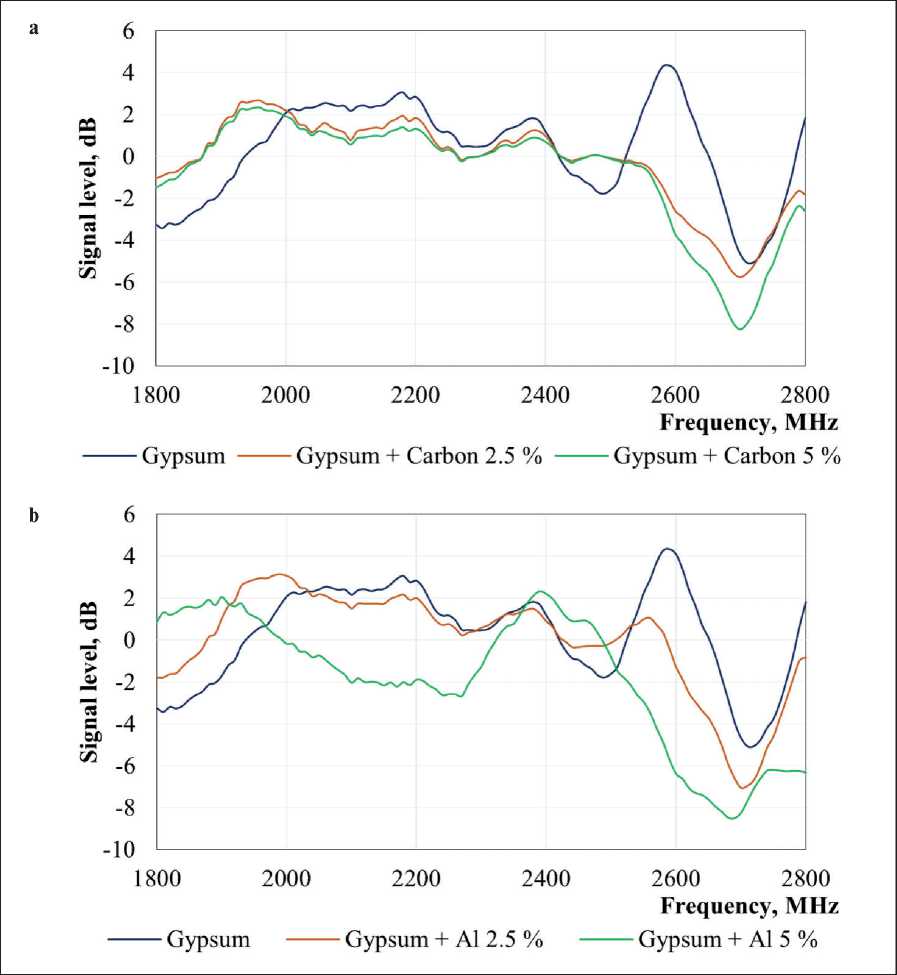
Fig. 2. The effect of additives in the gypsum matrix on fading of the radiation flux: a) black carbon; b) aluminum powder
(–1 dB) to 60 % (–8 dB) in the frequency ranges 2000– 2400 MHz and 2550–2800 MHz (Fig. 2).
Attention is drawn to the sections of the graphs where at some frequencies there is an excess of the signal level above 0 dB. This anomaly can be associated with a number of physical effects: wave interference, wave phase shift, generation of secondary waves, in addition, gypsum stone can act as a so-called microwave lens. To clarify the nature of this phenomenon, additional research is necessary, but the fact itself makes it necessary to carefully approach the choice of material for screening a certain range, as well as to look for ways to reduce this phenomenon.
A significant effect of aluminum powder on the radio shielding properties in the gypsum matrix is observed only at a 5% dosage. The reduction in the radiation level in this case ranges from 11% (–1 dB) to 69% (–10 dB) in the frequency ranges 1980–2350 MHz and 2520– 2800 MHz.
The carbon additive to the cement matrix shows its effectiveness in the frequency ranges 1800–2100 MHz and 2300–2650 MHz. At the same time, the average decrease in signal power is 50% (–6 dB).
Additionally, the screening qualities of water-saturated superabsorbent polymers, which can be used as a water
CONSTRUCTION MATERIALS SCIENCE
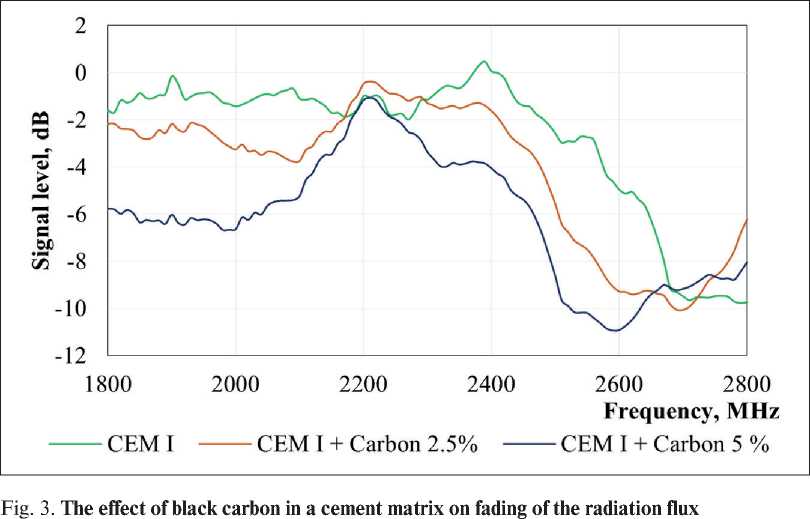
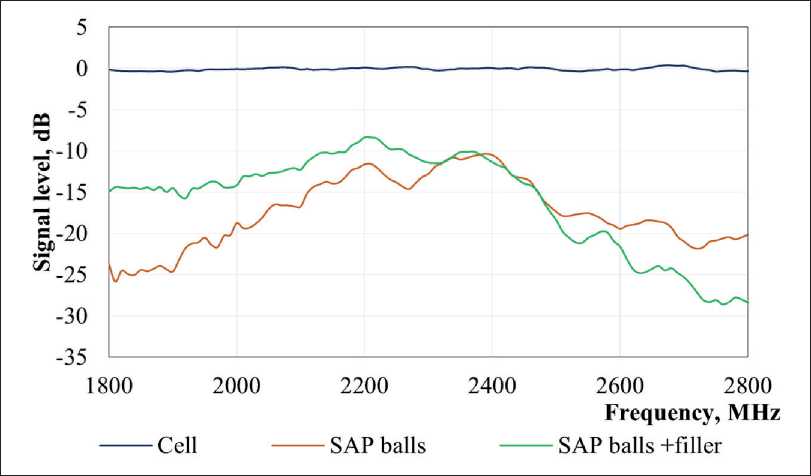
Fig. 4. Radio shielding with water-saturated superabsorbent polymers
replacement in various protective shells, were evaluated. The use of water in such an immobilized form makes it possible to completely eliminate the risk of its leakage if the protective structure is damaged. Two types of filling were considered:
– only SAP balls with an average diameter of 7 mm;
– balls with filling of intergranular voids with a gel made of a superabsorbent polymer (filler).
A study of the interference introduced by a special cell for liquid and bulk materials showed that their amount is no more than 2% (0.2 dB).
The study of SAP with filler (Fig. 4) showed a maximum decrease in the radiation level to 96% (–28 dB), the lowest – 60% (–8 dB) with a thickness of only 30 mm, due to the high dielectric constant of water and a high degree of energy absorption by it in this frequency range. When using balls without filler, the minimum power reduction was 72% (–11 dB), the maximum was 94% (–25 dB). The highest degree of shielding is achieved in the frequency range of 1800–2350 MHz. The higher efficiency of balls without filler may be due to multiple phase transitions (SAP – air) and, as a result, multiple
CONSTRUCTION MATERIALS SCIENCE refraction of the signal propagation vector with subsequent loss of energy.
The results obtained show that the use of SAP in architectural and decorative products can significantly increase their radio shielding properties in the microwave range, as well as architectural expressiveness, for example, by using as a filler for transparent structures (stained glass windows, windows, etc.). It is important to note that SAP tend to lose water under normal conditions and, as a result, they are applicable in insulated systems, for example, when using them as a filler for waterproof epoxy resins.
CONCLUSION
Monitoring the level of microwave electromagnetic radiation in buildings and structures can be an important step towards reducing the risk of a number of human diseases during prolonged stay in areas with high levels of microwave radiation.
A promising direction is to increase the microwave protective properties of traditional building materials used for the construction and decoration of walls by introducing electrically conductive additives (black carbon and aluminum powder) into the matrix of such composites.
The addition of carbon black in an amount of up to 3–3.5% by weight of cement shows a neutral effect on the strength of cement stone, providing a decrease in the signal level of about 50% (–6 dB) observed in the ranges of 1800–2100 MHz and 2300–2650 MHz, which makes this additive promising for solving the highlighted task.
When additives are introduced into the gypsum matrix, the addition of black carbon reduces the radiation level to 60% (–8 dB), and aluminum powder – to 69% (–10 dB) in a dosage of no more than 5% of the mass fraction of the binder on samples with a thickness of 3 cm. However, the additives considered have a noticeable negative effect on the strength parameters of gypsum stone, which allows us to recommend the use of only carbon black in an amount of no more than 2.5% to obtain products that do not require high strength, which is quite typical for construction tasks solved by gypsum.
Water-saturated SAP can be used as a filler for architectural and construction composites with enhanced radio shielding properties. The effectiveness of this filler can reach 96% (–28 dB) with dense packing of balls with a diameter of 7 mm with a total thickness of 30 mm layer. Separately, it is worth noting the possibility of increasing their architectural expressiveness of architectural and building forms when using SAP, for example, as a filler for transparent structures (stained glass windows, windows, etc.).
Список литературы Increasing the radioshielding properties of construction materials in the microwave range
- Kozlov A.N. A model for evaluating the damaging effect of powerful microwave radiation on rocket technology objects. Vestnik of Izhevsk State Technical University. 2007. Issue 3 (35): 109–111.
- Durusoy R., Hassoy H. Electromagnetic fields from mobile phones and their base stations: health effects. Reference Module in Earth Systems and Environmental Sciences. Encyclopedia of Environmental Health (Second Edition). 2019: 300–314.
- Kundi M., Hutter H.P. Mobile phone base stations – Effects on wellbeing and health. Pathophysiology. 2009; 16. Issue 2–3: 123–135.
- Grigotiev Y.G. Cellular communication and electromagnetic health hazards of the population. modern risk assessment– from electromagnetic smog to electromagnetic chaos (literature review). Journal of New Medical Technologies; 26. (2): 88–95.
- Grigoriev Yu.G. From electromagnetic smog to electromagnetic chaos. To evaluating the hazards of mobile communication for health of the population. Medical Radiology and Radiation Safety. 2018; 63 (3): 28–33.
- Davydova T.I. Protection from electromagnetic microwave fields. Automation of Control Processes. 2008; 3: 65–68.
- Apollonsky S.M. Protection of the technosphere from the effects of physical fields and radiation: monograph; 1. Types of physical fields and radiation. Regulatory and legal documents. Moscow: Rusains; 2018.
- Apollonsky S.M. Protection of the technosphere from the effects of physical fields and radiation: monograph; 2. Protective materials from physical fields and radiation. M.: Rusains; 2016.
- Belyaev A.A., Bespalova E.E., Lepeshkin V.V. Radio-absorbing materials based on finishing building materials for protection from microwave radiation of cellular base stations. Proceedings of VIAM. 2015; 6: 80–88.
- Kulik V.I., Nilov A.S. Prospects of application of polymer composite materials reinforced with carbon nanoscale fillers for electromagnetic radiation screens. Military Enginery. Issue 16: Counter-terrorism technical devices. 2019; 1–2 (127–128): 120–127.
- Jia H., Xing H., Ji X., Gao S. Self-template and in-situ polymerization strategy to lightweight hollow MnO2@ polyaniline core-shell heterojunction with excellent microwave absorption properties. Applied Surface Science. 2021; 537. Article number 147857.
- Du Y.C., Liu W.W., Qiang R., Wang Y., Han X.J., Ma J., Xu. Shell thickness-dependent microwave absorption of core-shell Fe3O4@C composites. ACS Applied Materials & Interfaces. 2014; 6: 12997–13006.
- Liu Q.H., Cao Q., Bi H., Liang C.Y., Yuan K.P., She W., Yang Y.J., Che R.C. CoNi@SiO2@TiO2 and CoNi@ air@TiO2 microspheres with strong wideband microwave absorption. Advanced Materials. 2016; 28: 486–490.
- Kang S., Qiao S., Cao Y., Hu Z., Yu J., Wang Y., Zhu J. Hyper-Cross-Linked polymers-derived porous tubular carbon nanofibers@TiO2 toward a wide-band and lightweight microwave absorbent at a low loading content. ACS Applied Materials & Interfaces. 2020; 12: 46455–46465.
- Liu X., Chen Y., Cui X., Zeng M., Yu R., Wang G.S. Flexible nanocomposites with enhanced microwave absorption properties based on Fe3O4/SiO2 nanorods and polyvinylidene fluoride. J. Mater. Chem. 2015; 3: 12197–12204.
- Liu T.S., Liu N., Zhai S.R., Gao S.S., Xiao Z.Y., An Q.D., Yang D.J. Tailor-made core/shell/shell-like Fe3O4@SiO2@PPy composites with prominent microwave absorption performance. Journal of Alloys and Compounds. 2019; 779: 831–843.
- Qiao M., Li J., Wei D., He X., Lei X., Wei J., Zhang Q. Chain-like Fe3O4@void@mSiO2@MnO2 composites with multiple porous shells toward highly effective microwave absorption application. Microporous and Mesoporous Materials. 2021; 314. Article number 110867.
- Wu Z., Pei K., Xing L., Yu X., You W., Che R. Enhanced microwave absorption performance from magnetic coupling of magnetic nanoparticles suspended within hierarchically tubular composite. Advanced Functional Materials. 2019; 29. Article number 1910448.
- Cao M.S., Song W.L., Hou Z.L., Wen B., Yuan J. The effects of temperature and frequency on the dielectric properties, electromagnetic interference shielding and microwave-absorption of short carbon fiber/silica composites. Carbon. 2010; 48: 788–796.
- Cao M., Wang X., Cao W., Yuan J. Ultrathin graphene: electrical properties and highly efficient electromagnetic interference shielding. Journal of Materials Chemistry C. 2015; 3: 6589–6599.
- Meng F., Wang H., Huang F., Guo Y., Wang Z., Hui D., Zhou Z. Graphene-based microwave absorbing composites: A review and prospective. Composites Part B Engineering. 2018; 137: 260–277.
- Cao M., Cai Y., He P., Shu J., Cao W. 2D MXenes: Electromagnetic property for microwave absorption and electromagnetic interference shielding. Chemical Engineering Journal. 2019; 359: 1265–1302.
- Wu F., Xie A., Sun M., Wang Y., Wang M. Reduced graphene oxide (RGO) modified spongelike polypyrrole (PPy) aerogel for excellent electromagnetic absorption. Journal of Materials Chemistry A. 2015; 3: 14358–14369.
- Li J., Zhou D., Wang P.-J., Du C., Liu W.F., Su J.Z., Pang L.X., Cao M.S., Kong L.B. Recent progress in two-dimensional materials for microwave absorption applications. Chemical Engineering Journal. 2021; 425. Article number 131558.
- Ning M., Lu M., Li J., Chen Z., Dou Y., Wang C., Rehman F., Cao M., Jin H. Two-dimensional nanosheets of MoS2: a promising material with high dielectric properties and microwave absorption performance. Nanoscale. 2015; 7: 15734–15740.
- Huang L., Chen C., Li Z., Zhang Y., Zhang H., Lu J., Ruan S., Zeng Y. Challenges and future perspectives on microwave absorption based on two-dimensional materials and structures. Nanotechnology. 2020; 31 (16). Article number 162001.
- Liu J., Zhang H., Sun R., Liu Y., Liu Z., Zhou A., Yu Z. Hydrophobic, Flexible, and Lightweight MXene Foams for High-Performance Electromagnetic-Interference Shielding. Advanced Materials. 2017; 29. Article number 1702367.
- Naguib M., Kurtoglu M., Presser V., Lu J., Niu J., Heon M., Hultman L., Gogotsi Y., Barsoum M.W. Twodimensional nanocrystals produced by exfoliation of Ti3AlC2. Advanced materials. 2011; 23(37): 4248–4253.
- Wang H., Ma H. The electromagnetic and microwave absorbing properties of MoS2 modified Ti3C2Tx nanocomposites. Journal of Materials Science: Materials in Electronics. 2019; 30: 15250–15256.
- Sista K.S., Dwarapudi S., Kumar D., Sinha G.R., Moon A.P. Carbonyl iron powders as absorption material for microwave interference shielding: A review. Journal of Alloys and Compounds. 2021; 853. Article number 157251.
- Grafkina M.V., Nyunin B.N., Sviridova E.Y. Improvement of the monitoring system of electromagnetic safety of residential premises. Bulletin of BSTU named after V.G. Shukhov. 2013; 4: 40–42.
- Podgornyi D.S., Elistratkin M.Y., Bondarenko D.O., Alfimova N.I., Strokova V.V. Assessment of microwave screening by construction materials. STIN. 2023; 8: 30–33.

